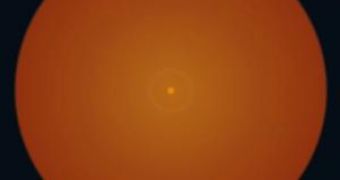Novae usually originate in binary star systems made of a white dwarf star and a red dwarf. Since the red dwarf is unable to hold its mass together, material is siphoned towards the surface of the white dwarf, where it accumulates until the star becomes unstable and initiates thermonuclear reactions in the outer material shell. As this happens, a massive explosion ejects the surplus matter into space, making the system several times brighter than usual.
Now the ESO Very Large Telescope Interferometer was used for the first time to monitor the evolution of a shell of material ejected into space during a nova event, with high accuracy for at least three months. The object of study, known as Scorpii 2007a, is a binary star system that was discovered on February 4, 2007 as it enhanced its brightness to become one of the brightest novae in more than three decades.
Several days after reaching its maximum brightness, the researchers observed how a shell of dust and gas formed around the object enveloping it for more than half a year. Observations with the AMBER near-infrared instrument showed that 23 days after the nova event the source was still very compact, and seemed to have increased its size 13 times in just a few days.
"It is most likely that the latter size corresponds to the diameter of the dust shell in expansion, while the size previously measured was an upper limit of the erupting source," said Olivier Chesneau, the lead author of the study. Following the increase in the visible size of the dust shell, later observations showed that the dust and gas shell continued to increase its volume at a rate of 2 million kilometers per hour.
"This is the first time that the dust shell of a nova is spatially resolved and its evolution traced starting from the onset of its formation up to the point that it becomes too diluted to be seen", says Dipankar Banerjee, co-author of the study.
Correlating the expansion rate of the object and the angular appearance, astronomers then calculated that the star system was located about 5,500 light years away. Chesneau argues that the V1280 Scorpii ejected about 33 times more material than the total mass of the Earth from a white dwarf star comparable in diameter to our planet, although less than one percent of this material was actually converted into dust.

 14 DAY TRIAL //
14 DAY TRIAL //